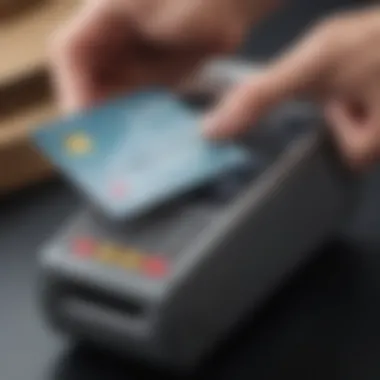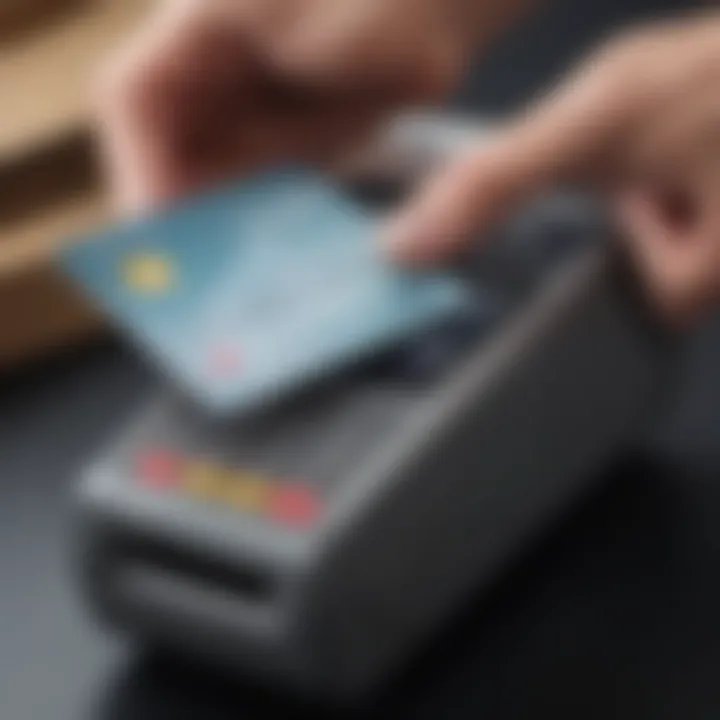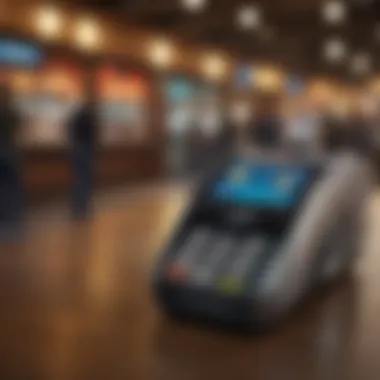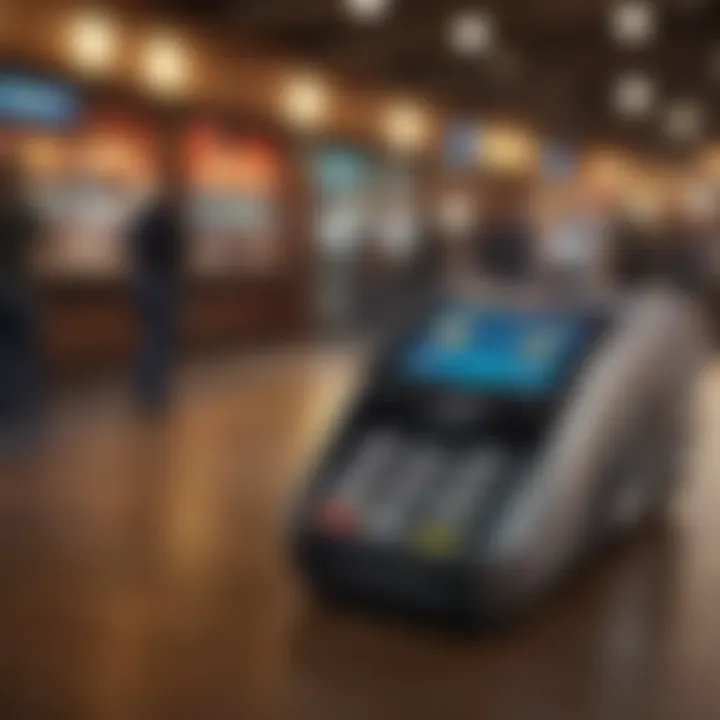Exploring the Landscape of Credit Card Contactless Technology


Intro
In today’s fast-paced world, the way transactions occur has radically shifted, making room for ease and innovation. Contactless credit card technology stands at the forefront of this transformation, combining convenience with security. For many, the idea of waving a card over a terminal instead of fiddling with cash or inserting a chip card may seem like magic. However, there’s much that underpins this modern marvel.
Understanding the mechanics of contactless payments isn't just for tech aficionados; it's crucial for anyone engaging with financial systems. This exploration invites both novices and seasoned experts to dissect the concept, a blend of electromagnetic fields, smart security protocols, and consumer interplay.
As we delve deeper, we will uncover the underlying technology, examine user experiences, and venture into the expanding terrain of future financial transactions. Through this lens, the article will not only highlight the advantages of contactless payment systems but also scrutinize the challenges and risks that accompany this leap towards convenience. Each section aims to enrich your understanding and prepare you to navigate the complexities of modern financial transactions in this ever-evolving landscape.
Investment Terminology
This section serves as a gateway into the essential language of credit card contactless technology. Understanding key terms and acronyms can make a significant difference in grasping the broader context of how these transactions function.
Key Terms and Definitions
- NFC (Near Field Communication): This is the technology that enables contactless payment. It allows devices to communicate wirelessly when they are close together, typically within a few centimeters.
- EMV (Europay, MasterCard, and Visa): This technology standard ensures that the chip embedded in credit cards securely communicates with payment terminals.
- Tokenization: This process substitutes sensitive card information with a unique identifier or token, providing an extra layer of security during transactions, making it difficult to intercept personal data.
Common Acronyms in Finance
- PIN (Personal Identification Number): A numerical code that serves as security for card transactions.
- CNP (Card Not Present): Refers to transactions where the cardholder is not physically present during the transaction, such as online purchases.
- RTGS (Real-Time Gross Settlement): A system for settling interbank transactions in real-time, ensuring immediate finality of payments.
Understanding these terms is akin to having a toolkit in your back pocket—it equips you to better comprehend the complexities of credit card contactless technology and its implications in the broader scope of finance.
Prelude to Credit Card Contactless Technology
In the fast-paced world of financial transactions, credit card contactless technology has emerged as a game-changer. This method is not just a novel way to pay; it has shifted the landscape of consumer behavior and payment systems. Understanding this technology is crucial for both novices and seasoned investors alike. It provides insights into the modern shopping experience, where convenience is king, but security and efficiency must not be overlooked.
The surge in popularity of contactless payments is indicative of a growing demand for faster, simpler transaction methods. This technology has become synonymous with hassle-free payments, allowing consumers to tap and go in a matter of seconds. The benefits extend well beyond mere speed. It promotes a seamless user experience, caters to a tech-savvy demographic, and opens avenues for businesses to enhance service levels.
In exploring credit card contactless technology, we discover a wealth of considerations. From understanding the inner workings of RFID and NFC protocols to examining the evolution of payment habits, this overview will cover it all. Beyond the technical features, it will delve into the socio-cultural implications, the security challenges posed, and how consumers are adapting to this form of payment over time.
As we embark on this deep dive, it’s essential to grasp not only the mechanics but also the implications of adopting such a transformative technology. The narrative that unfolds here will immerse you in the developments of contactless payments, helping you navigate the complexities and nuances of modern financial transactions.
Definition and Background
At its core, credit card contactless technology facilitates transactions without needing physical contact, using waves or pulses generated by radio frequencies. The foundation of this technology can be traced back to the development of Radio Frequency Identification (RFID) systems, which were initially deployed in various sectors like inventory management and access control. The method evolved significantly; today, it's incorporated into everyday transactions, merging convenience with technological advancement.
Contactless payment systems utilize either RFID or NFC (Near Field Communication) technology to transmit data securely between the card and a payment reader. When a consumer hovers their card near a reader, encrypted data is exchanged, allowing the transaction to process swiftly. It’s the kind of instant gratification today’s consumer has come to expect, offering a stark contrast to the lengthy chip-and-pin process.
Evolution of Payment Methods
The evolution of payment methods has been rapid, reflecting shifts in consumer needs and technological progress. Once upon a time, cash was king. Enter debit and credit cards, which revolutionized the way payments were made by providing a convenient alternative to coins and notes. However, as with all innovations, there's always room for improvement. Initially, cards were swiped through a reader, the noise marking the end of the transaction.
As mobile technology burgeoned, so too did the desire for seamless transactions. The evolution to contactless methods can be seen as an answer to these demands. With time, the process shifted from swipe to chip-and-pin, and finally, to contactless payments. In today’s context, contactless technology stands as both a reflection of consumer preferences and a testament to the pace of innovation in the financial landscape.
Thus, it's evident that our financial habits are continuously evolving, intertwined with technological advancements. The trend is heading towards efficiency, favoring methods that save time while maintaining security and trust. Understanding this trajectory is pivotal, not just from a consumer's viewpoint, but also from a broader financial perspective. This knowledge can help both businesses and consumers adapt to an ever-changing financial world.
Mechanisms Behind Contactless Payments
Understanding the mechanisms behind contactless payments is crucial as it lays the foundation for grasping how these systems revolutionize transactions. With the world shifting towards faster and more seamless payment options, contactless technology emerges as a trailblazer in the financial ecosystem. This section sheds light on the underlying technologies, specifically the RFID and NFC protocols, while drawing comparisons with traditional payment methods such as swipe and chip-and-pin.
How Contactless Cards Function
RFID Technology
RFID, or Radio Frequency Identification, is one of the core technologies behind contactless cards. At its heart, RFID allows for the wireless transfer of information over short distances. A key characteristic of RFID is its use of electromagnetic fields to automatically identify and track tags attached to objects. In the context of payments, this means that as soon as a contactless card comes into proximity with a reader, transaction data can be exchanged almost instantly.
One unique feature of RFID technology is its ability to work without requiring direct line-of-sight, which is particularly beneficial in crowded environments like public transport or retail outlets. However, while RFID is robust, it does face some challenges. For instance, it can be susceptible to interception by unauthorized devices, potentially leading to data breaches. Nevertheless, its advantages, such as enhancing transaction speed and reducing waiting times, make RFID a popular choice for modern payment systems.
NFC Protocols
NFC, or Near Field Communication, builds on the principles of RFID but takes it a step further by emphasizing two-way communication. This characteristic allows devices to not only read transactions but also to send back data. NFC has gained traction in mobile payments, providing another layer of convenience alongside traditional cards.
One defining feature of NFC is its secure element, which holds sensitive payment data and ensures that transactions occur only when two devices are close enough—typically within a few centimeters. While NFC is generally seen as a safe and efficient method for contactless payments, potential issues like mobile phone compatibility and the need for constant battery life can be considered drawbacks. However, the convenience it provides generally outweighs these concerns, particularly among tech-savvy users eager for efficiency in their financial transactions.
Comparative Analysis with Other Payment Methods
Swipe
When comparing contactless payments to the traditional swipe method, one can easily see the differences in efficiency. The swipe method, while familiar, requires physical contact with the card reader and can take longer than desired during busy periods. This method relies on magnetic stripes, which can become demagnetized over time, causing frustration for users.


On the other hand, the swipe method entails a straightforward and minimalist mechanics, making it accessible to a wide user base. Nonetheless, it can't hold a candle to the speed of contactless transactions, which can be completed in a fraction of the time. In this day and age, where convenience is king, swipe technology is slowly getting overshadowed.
Chip and Pin
Chip and Pin technology introduced a new layer of security to transactions, yet it still doesn't match the sleekness of contactless payments. The process of inserting the card and entering a PIN can feel cumbersome, especially in scenarios where time is of the essence, such as during a quick coffee run.
A major advantage of Chip and Pin lies in its added security, thanks to the encrypted data it uses compared to the less secure magnetic strip. However, users are increasingly favoring speed and ease, which places contactless payments at the forefront, thanks to their efficiency, especially for small transactions where PIN entry feels superfluous.
In summary, the mechanisms behind contactless payments reveal a world driven by technological innovation, focusing on speed, convenience, and improved user experiences. As consumers become more accustomed to these methods, it raises questions about the future of traditional payment methods.
"The shift towards contactless technology isn't just a trend; it reflects changing expectations around payment speed and convenience in everyday life."
As technology continues to advance, one can only imagine what further innovations lie on the horizon.
Advantages of Using Contactless Cards
Contactless cards have matured into a cornerstone of modern financial transactions, offering users a plethora of advantages that align well with the demands of contemporary life. As our world becomes increasingly fast-paced, convenience and speed become paramount, and these cards respond to those needs deftly.
One of the most notable strengths of contactless cards is the speed with which they allow transactions to occur. Gone are the days of fumbling with loose change or waiting for a receipt to print—consumers can now tap their cards and be on their way in the blink of an eye. This shift transforms not just individual experiences but elevates transactions across the board, impacting everything from busy coffee shops to large retail chains.
Speed and Convenience
Speed encapsulates a vital element of contactless payment technology. This method not only reduces the time spent at the checkout but also enhances the overall shopping experience for the user. The immediacy of contactless transactions means you can make purchases without the typical complications associated with cash or even traditional card swipes. In many cases, users simply need to hover their cards over a reader, and voila, the payment is processed. It’s as effortless as pie.
As a result, businesses can serve more customers in less time, which naturally leads to a smoother business operation. This immediate benefit is particularly attractive for retailers looking to improve, or at least maintain, foot traffic in a competitive market.
Enhanced User Experience
Contactless cards greatly contribute to an enhanced user experience, characterized by two specific areas: reducing queuing times and ease of transactions. These elements work together to not only better individual experiences but also streamline the overall process of payment. Here’s a deeper dive:
Reducing Queuing Times
The aspect of reducing queuing times is significant in understanding customer satisfaction. Long lines can be a dealbreaker for many shoppers, leading them to seek more efficient alternatives. By implementing contactless payments, businesses can drastically shorten the time each customer spends in line. Imagine standing in line for your morning coffee, and suddenly you see a handful of people breezing through the checkout, card in hand.
This characteristic of quick transactions promotes a favorable image of a brand or service, giving customers a reason to return. The unique feature of this efficiency—being able to make a purchase in a fraction of the time—has increasingly become a priority for consumers everywhere. As such, businesses that adopt this technology can expect a ripple effect of returning customers, bolstered not just by speed but by their satisfaction with the overall service.
Ease of Transactions
Another key factor promoting user satisfaction in contactless payments is the ease of transactions. For many consumers, fumbling for cards or cash at crowded stores can lead to frustration. Contactless cards mitigate this issue, allowing users to tap and go without hassle. This smoothness makes shopping less of a chore and more of a habit—everyone enjoys ease in their life, right?
The ability to quickly complete a transaction means less time worrying about forgetting your pin or finding the correct change. Instead, individuals can focus on what really matters, whether it be their groceries, gifts, or simply enjoying life. However, while ease of use is often a clear advantage, it's worth noting that it may also leave less tech-savvy users feeling a bit out of the loop. Nonetheless, the overall convenience tends to outweigh these concerns.
In summary, the advantages of using contactless cards—punctuated by speed and enhanced user experience—create a compelling narrative for their adoption. They offer not just a way to pay but a means to fit financial transactions seamlessly into the everyday rhythm of life.
Security Considerations
As the financial landscape continues to shift towards more convenient payment methods, understanding the security considerations associated with contactless credit card technology becomes paramount. The essence of this section is to dissect both the risks and protective measures that come into play when using contactless cards. As these transactions gain traction, the sensitivity surrounding security raises pertinent questions about data protection and user safety. Exploring these aspects is vital for consumers, financial institutions, and technologists, as it aids in fostering trust and ensuring a smoother adoption of contactless payments.
Risks Associated with Contactless Transactions
Data Theft
Data theft presents a significant concern in the realm of contactless payments. With the ability to process transactions at a distance, sensitive information can potentially be intercepted. This aspect is crucial because it showcases how criminals might exploit the technology for illicit gains. The key characteristic of data theft in this context lies in its stealthiness; hackers can deploy scans to capture data without ever needing physical access to the card.
A distinct feature of this threat is the relative ease with which perpetrators can access confidential information. With the right equipment, they can skim card details, making it an attractive avenue for those with malicious intent. This situation can lead to severe consequences, such as unauthorized transactions or identity theft, which are additional layers of challenges this article seeks to address.
Unauthorized Transactions
Unauthorized transactions are another pressing issue related to contactless payment methods. This occurs when a cardholder's account is accessed without consent, leading to charges that the user did not initiate. This risk is critical as it directly impacts consumer trust in contactless technology. The salient feature of this concern is its connection to the user’s perceived control over their financial activities. When a payment is made without authorization, it raises alarms about the safety of the user’s financial data.
Such transactions illustrate why a cautious approach is vital in leveraging contactless technology. Despite its myriad benefits, the anxiety stemming from unauthorized access can deter individuals from utilizing these innovations. Hence, this aspect is a pivotal topic of discussion, considering its implications for user confidence and market penetration of contactless solutions.
Security Measures Implemented
Encryption
Encryption serves as a cornerstone in safeguarding contactless payments. This process involves encoding data so that it is accessible only to those with the corresponding decryption key. In the realm of contactless cards, encryption defines how transactional data is protected during the transfer process. This method is particularly beneficial as it ensures that intercepted data remains unreadable to unauthorized parties, significantly reducing the risk of data breaches.
The unique feature of encryption lies in its dual function: it not only protects users' data but also fosters trust between consumers and financial institutions. By implementing rigorous encryption measures, banks can reassure users that their transactional information remains confidential, thereby encouraging the adoption of contactless payments. The effectiveness of encryption cannot be overstated; it creates a less hospitable environment for would-be data thieves, which is vital for the overall health of modern payment systems.
Tokenization


Tokenization is another pivotal security measure that converts sensitive data into unique identification symbols or "tokens". During contactless transactions, the actual card details are never transmitted; instead, a token substitutes the sensitive information, making it significantly harder for hackers to exploit. This additional layer of security adds a promising dimension to the conversation about safety in contactless payments.
The primary characteristic of tokenization is its ability to enhance security without compromising user experience. This feature ensures that consumers can swiftly complete transactions while their information remains secure. Tokenization's advantage is that it reduces the pool of usable data that thieves can target. By erasing sensitive information from the transaction process, it ultimately minimizes the likelihood of fraud while making contactless technology a more viable choice for everyday use.
As we delve further into the realm of contactless payments in subsequent sections, keeping an eye on these security considerations will be essential in appreciating the technology's full potential. Understanding these risks and measures can pave the way for a more informed user base, poised to engage with an ever-evolving payment landscape.
User Adoption and Behavior
Understanding user adoption and behavior is pivotal in grasping how contactless technology integrates into the financial ecosystem. As technology evolves, how consumers adapt to these changes can significantly influence the future of payment methods. Several factors play into this, from the speed at which consumers adopt new technology to the attitudes they hold towards these innovations.
Current Trends in Consumer Usage
As of late, consumer preference has been shifting towards contactless payments. This change stems from the desire for convenience, quick transactions, and a growing familiarity with technology. According to recent surveys, more people are opting for contactless methods, nearly tripling their usage in just a few years. What once felt novel is now a standard way to handle daily transactions, especially among younger generations.
People now expect payments to happen at the speed of light. It’s common to see individuals using their contactless cards at coffee shops or grocery stores, often with a simple tap. This growing acceptance reflects a trend toward a more seamless shopping experience.
Factors Influencing User Acceptance
Age Demographics
Age plays a significant role in how users respond to contactless technology. Younger consumers, particularly those aged 18 to 34, seem to embrace innovation without a second thought. This demographic has grown up in a digital world where instant access to information and services has become the norm. Consumers in this group often find themselves adept at learning new technological tools, equipping them to appreciate the functionalities of contactless payments.
In contrast, older generations may exhibit hesitation. Their financial habits are typically entrenched, making them more wary of adopting new payment methods. However, it's essential to note that education can bridge this gap as more seniors are becoming tech-savvy, often looking for convenience that contactless payments offer.
The adaptability of younger generations serves as a driving force in the acceleration of contactless payment adoption. It's this very characteristic that reshapes expectations for how financial transactions should occur.
Cultural Attitudes
Cultural attitudes shape how communities perceive and use contactless technology. In some cultures, the acceptance of technological advancements occurs rapidly, while in others—often influenced by historical context—there's a palpable skepticism towards digital transactions.
For instance, societies that prioritize cash transactions might take longer to adopt contactless payments. The idea of parting with physical cash holds symbolic weight in many cultures, influencing consumer behavior over time. Conversely, countries like Sweden have illustrated a thriving acceptance of contactless technology, with many opting for digital means over cash.
This divergence provides valuable insight into the broader implications of user adoption. Attitudes toward financial security, privacy, and convenience play significant roles. As these cultural equations evolve, they set a tone for the adoption rates of new technologies, including contactless payments.
"Understanding the interplay of demographic and cultural elements can consistently redefine how contactless technology is perceived and utilized."
In summary, the dynamics of user adoption and behavior are multi-faceted. It encompasses a mixture of age-related factors and cultural backgrounds, creating a rich tapestry of preferences and habits that shape the landscape of contactless payments. By examining these elements, stakeholders can better strategize ways to enhance acceptance and usability in the years to come.
Global Perspectives on Contactless Payments
The rise of contactless payment methods reshapes how consumers and businesses interact in various regions. Understanding global perspectives on contactless payments is crucial for recognizing the diverse factors influencing its adoption. Different regions exhibit a unique blend of cultural, technological, and regulatory influences that drive or hinder the use of contactless cards. Exploring these variations helps to contextualize the overall impact and effectiveness of contactless technology in the global marketplace.
Regional Variations in Adoption
North America
In North America, contactless payments have carved their niche mainly due to the prevalent technology infrastructure and the heavy dependence on credit cards. Notably, major cities like New York and San Francisco embrace contactless payments not just in retail, but also in public transport systems. This broad incorporation drastically enhances the user experience. The key characteristic of North America is its rapid adaptation, fueled by consumers’ persistent quest for convenience.
However, not everything is rosy. While the speed and ease of transactions are praised, there are lingering fears regarding security, creating a tug-of-war between growth and safety. The unique feature of North America is that merchants often offer incentives for customers to use contactless methods, making it a beneficial choice for businesses aiming for increased sales.
Europe
Europe stands as a trendsetter in the realm of contactless payments, with countries like the UK and Sweden embracing this technology at a pace that puts others to shame. The European Union’s commitment to digital innovation and strong consumer protection laws create a fertile ground for contactless transactions. The key characteristic here is the societal receptiveness toward new payment technologies, largely because many European consumers prioritize seamless experiences over traditional payment methods.
A distinct trait of Europe is the harmonization of payment standards across member states. This can serve as a double-edged sword; while it facilitates a smoother experience for consumers traveling across borders, it can pose challenges when it comes to differing regulations and market readiness amongst various countries.
Asia
Asia presents a fascinating tapestry of contactless payment adoption. Nations like China lead with staggering growth rates, propelled by giants such as Alipay and WeChat Pay. This region is characterized by widespread mobile payment usage, making contactless transactions not just a convenience, but a cultural norm. The notable aspect of Asia is the integration of payments into everyday life, as mobile wallets are not merely for shopping but also encompass a variety of services including bills and transfers.
While the rapid adoption is often viewed as advantageous, it comes with its own set of challenges. Variability in technology infrastructure and regulatory frameworks among Asian countries can hinder uniform growth. Additionally, the rush towards contactless payments raises questions about security, especially as digital fraud incidents rise.
Regulatory Considerations
Navigating the regulatory landscape for contactless payments is crucial. Different regions adopt unique frameworks that influence how payment systems operate. For instance, the EU framework emphasizes stringent data privacy laws, while the U.S. favors a more decentralized approach. Understanding these regulatory nuances not only underscores the viability of contactless technologies but also impacts user confidence and trust.
"A solid grasp of regulatory considerations can make or break the adoption of any payment technology."
By weaving through the varied regional lenses and regulatory details, the article aims to paint a comprehensive picture of the global landscape for contactless payments. Each region’s distinctive characteristics contribute to a rich narrative that enhances our understanding of this modern payment phenomenon.
Challenges Facing Contactless Technology


The journey into contactless payments is not all smooth sailing. Despite the evident benefits and progressive acceptance, several challenges hinder the broader adoption and functionality of contactless technology. Recognizing these challenges is imperative, as it doesn’t just showcase potential weaknesses but also opens avenues for improvements and innovations in the payment landscape. In a world aiming for increased efficiency, understanding these hurdles allows both consumers and stakeholders to navigate the complexities associated with contactless transactions effectively.
Technical Limitations
Technical limitations play a pivotal role in how contactless payment systems operate. One significant hurdle is range. Contactless cards typically require close proximity to the reader – often just a few centimeters. While this proximity ensures security, it can also lead to user frustration when readers malfunction or when there are multiple cards in the vicinity. It’s not uncommon for transactions to fail because the card didn’t register with the machine on the first try.
Furthermore, the infrastructure to support contactless payments is still developing in many areas. In particular, smaller retailers or vendors in rural regions may not have upgraded their payment systems to accommodate contactless features. In these scenarios, consumers eager to pay with their cards could find outdated technology hampers their experience.
Then, there are concerns regarding compatibility between various types of cards and readers. Not all contactless cards use the same technology or protocols. For example, NFC-enabled devices may not always seamlessly interact with machines that rely on RFID. This inconsistency can disrupt transactions and lead to confusion for users unfamiliar with the nuances of contactless payment systems.
To summarize, key technical limitations include:
- Need for close proximity to readers
- Underdeveloped infrastructure in certain areas
- Compatibility issues between different technologies
Consumer Misconceptions
Consumer misconceptions also pose a significant barrier to the widespread acceptance of contactless payments. Some individuals hold the belief that contactless cards are easily hackable or that a quick tap could lead to unauthorized transactions. This notion creates an air of distrust, making them reluctant to embrace the technology despite its built-in security measures. The reality is that contactless transactions often have safeguards such as encryption and tokenization that help protect users’ information.
Additionally, many consumers are not fully aware of how contactless payments work. They might perceive the act of tapping a card as having less control over the transaction compared to swiping or inserting a chip card. This sense of loss of control can lead to anxiety or skepticism regarding the reliability of the technology.
Moreover, myths regarding limits on transaction amounts can also deter users. Many believe that they cannot spend beyond a certain threshold without using traditional methods, which might not always be true. As such, education about the technology is vital to dispel these myths and build confidence in utilizing contactless methods.
"Consumer trust and understanding are pivotal in the full integration of contactless systems into everyday life."
Future Implications of Contactless Payments
As society continues to evolve with the rapid pace of technology, credit card contactless payments stand on the brink of a significant transformation. This section delves into the expected advancements and how they might revolutionize our understanding and experience of transactions. Grasping the future implications of contactless technology is essential, as it encompasses a myriad of factors that affect consumers, businesses, and the overall financial ecosystem.
Expected Technological Advancements
With advancements in technology, the landscape of contactless payments is set to expand significantly. One of the most promising changes on the horizon is the enhancement of security protocols. As more transactions take place without physical contact, the urgency for robust encryption methods increases. For instance, better algorithms and biometric authentication could dramatically reduce fraud risks. This means that transactions, while still swift, may become increasingly secure, offering peace of mind to consumers.
Furthermore, the integration of artificial intelligence in contactless payment systems is poised to streamline user experiences. Imagine a world where your payments are processed so quickly, that the thought of carrying cash becomes archaic. AI could facilitate personalized offers at the point of sale, shaping a more dynamic shopping experience. In essence, the technological advancements coming our way may lead to a blend of convenience and personalization that was once the realm of science fiction.
Integration with Emerging Technologies
As we look forward, the fusion of contactless payments with emerging technologies like mobile wallets and cryptocurrencies signifies a fundamental shift in transaction methodologies.
Mobile Wallets
Mobile wallets represent a cornerstone of today’s payment ecosystem. These are applications that enable users to store funds, credit card information, and loyalty cards on their smartphones. The standout characteristic of mobile wallets is accessibility. With merely a tap, transactions can be conducted almost anywhere, be it a coffee shop or an online retailer.
The unique feature of mobile wallets is their compatibility with various payment methods and their ability to keep track of receipts and loyalty points. This could lead to savings and perks that traditional cards often miss. Yet, potential limitations exist. Some users may feel apprehensive about privacy concerns, particularly as more personal data gets stored digitally.
Cryptocurrencies
Cryptocurrencies also show promise in the realm of contactless payments. At their core, they offer fast, borderless transactions, which could potentially be more efficient than traditional banking systems. What sets cryptocurrencies apart is their decentralized nature, which allows transactions to happen without intermediaries.
Despite their advantages, cryptocurrencies come with their own set of challenges. Volatility can pose a risk for consumers who use them for everyday transactions. Imagine the discomfort of having paid for a meal today only to find that your cryptocurrency's value has plummeted tomorrow. Thus, the integration of cryptocurrencies in contactless payments can be both a boon and a bind.
The future of contactless payments is not just about speeding up the checkout process. It's about marrying convenience with security, personalization, and adaptability. As we stand at this juncture, understanding these future trends can guide both consumers and businesses in navigating the fast-paced world of financial transactions.
The End
The conclusion serves as a crucial synthesis of the findings discussed throughout the article. It is not merely a summary but a reflection on the cumulative insights gained about credit card contactless technology. This technology is revolutionizing how we engage in financial transactions, leading to more streamlined processes and increased consumer satisfaction. It highlights the ease of use and the potential benefits that come along with such advancements, reinforcing the idea that convenience is paramount in today’s fast-paced society.
In reviewing the key points, we recognize several critical themes:
- The technological backbone, including RFID and NFC, has redefined transaction methods.
- Adoption rates vary globally, influenced by regional regulations and cultural attitudes.
- Despite security concerns, ongoing advancements in encryption and tokenization are enhancing safety.
- Misunderstandings about the technology can impact consumer acceptance.
- Future trends indicate further integration with mobile wallets and possibly cryptocurrencies.
Each of these aspects contributes to a broader understanding of the topic, making it clearer why this area is worth exploring. The transition towards contactless payments offers both challenges and opportunities, and by delving into them, we enable a richer dialogue on the future of financial interactions.
Summary of Key Points
In this comprehensive exploration of contactless technology, we’ve delineated several vital points:
- Definition and Background: Established the framework around contactless payment methods, tracing their evolution in a digitally-driven marketplace.
- Mechanisms: Elaborated on how contactless cards operate through RFIDs and NFC, improving the purchasing experience.
- Advantages: Emphasized the speed, convenience, and enhanced user experience that contactless payments provide.
- Security Considerations: Analyzed the risks associated, while discussing considerable security measures, such as encryption methodologies and tokenization.
- User Adoption: Evaluated how demographics and cultural attitudes inform consumer behavior regarding these technologies.
- Global Perspectives: Provided insights into the regional variations in contactless payment adoption, shining light on regulatory factors at play.
- Challenges: Addressed the technical limitations and prevalent misconceptions hindering broader acceptance.
- Future Implications: Speculated on anticipated technological advancements and their potential synergy with emerging technologies like mobile wallets.
By synthesizing these elements, the conclusion affirms the pivotal role of contactless technology in shaping future transactions.
Final Thoughts on the Evolution of Contactless Payments
As we reflect on the evolution of contactless payments, it becomes evident that we are witnessing a significant paradigm shift in financial dealings. This shift is not just about convenience but represents the broader trends towards digitization and enhanced efficiency. The trajectory suggests that we will continue to see innovations that further seal the gap between consumer demand for seamless financial interactions and the technologies available to meet those needs.
Consumer behavior is critical as well. The collective hesitance and excitement around new payment forms underscore the way we approach technology in our lives. It’s fascinating to note how swiftly some have adapted in places like Asia, while others remain skeptical. This varying pace of adoption emphasizes the importance of education and trust in new technology.
In essence, the evolution of contactless payments lights the path towards a future where the landscape of transactions is likely to be transformed significantly. With emerging technologies on the horizon, such as mobile wallets and cryptocurrencies, we could be at the forefront of a financial revolution. This article hopes to equip readers with awareness and insights, as we stand on the brink of what might come next in the world of payment technology.















